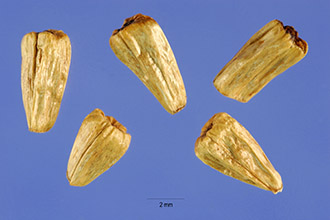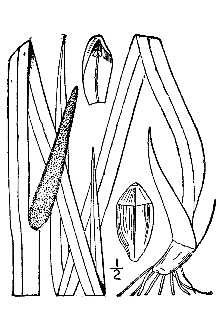Calamus
Scientific Name: Acorus calamus L.

| General Information | |
|---|---|
| Usda Symbol | ACCA4 |
| Group | Monocot |
| Life Cycle | Perennial |
| Growth Habits | Forb/herb |
| Native Locations | ACCA4 |
Plant Guide
Use soil moisture sensors to measure the soil moisture of Calamus.
Fact Sheet
Alternate Names
Calamus
Uses
Cultural Primarily, sweet flag is or was known by the American Indian tribes and early settlers for its medicinal value, Use soil moisture sensors to measure the soil moisture of Calamus., Although the preparation of this species and the ailments it treats vary somewhat among the tribes, rhizomes are the most commonly used part, Wildlife Sweet flag provides habitat for waterfowl, Muskrats eat the rhizomes and wood ducks consume the seed,
Status
Please consult the PLANTS Web site and your State Department of Natural Resources for this plant’s current status (e.g. threatened or endangered species, state noxious status, and wetland indicator values).
Description
Sweet flag is a perennial, rhizomatous, iris-like herb. The erect, sharp-pointed, sword-shaped leaves fan-out from a pinkish base and grow to 5 feet in length. The midvein is usually off-center. Cut or bruised leaves produce a sweet, tangerine-like scent. The flower stem, or scape, arises from the base of the outer leaves. Although resembling a leaf, the scape is triangular in cross section. A long, erect bract, or spathe, extends beyond the scape. A single, cylindrical 2 to 4-inch spike, or spadex, angles upward at this union. The slightly curved spadix is crowded with small yellowish-green to brown flowers that appear from May to July. Sweet flag has thick, creeping rhizomes with brownish exteriors and white, fleshy interiors. Tony Bush Rose Lake Plant Materials Center East Lansing, Michigan
Adaptation and Distribution
Distribution
Distribution
Sweet flag is irregularly circumboreal. In North America it is found from Nova Scotia and Quebec to Minnesota, Alberta and Eastern Washington, south to Florida, Texas and Colorado on wet soils and shallow water in ditches, marshes, river edges and ponds. It prefers full sun and a pH range from 5 to 7. For a current distribution map, please consult the Plant Profile page for this species on the PLANTS Website.
Establishment
Sweet flag can be propagated vegetatively by plant or rhizome division, and by seed. Vegetative propagation is best completed in the fall or spring using firm, healthy rhizomes cut into 2- to 4-inch sections. Plant sections in rich soil 4 - 6 inches deep and 1 foot apart. Separating individual sprigs from clumped plants is an alternative to using rhizomes. These should also be transplanted at 1-foot spacings. Seed should be planted during the fall or winter in a greenhouse. Fill a 2-inch deep tray with an organic soil mix, scatter seed sparsely on the surface and press firmly into the soil. Do not bury further than 1/8 inch deep. Keep soil moist to saturated. Seed does not require stratification and germinates in less than 2 weeks. When plants reach 3 to 4 inches transplant into individual 4-inch pots. Pots can be placed in shallow water or irrigated frequently to maintain very moist to saturated conditions. Transplant outdoors 1 foot apart in the spring. With adequate moisture seed can also be planted outdoors spring through early summer, or in a cold frame late summer through fall.
Plant Traits
Growth Requirements
| Temperature, Minimum (°F) | -38 |
|---|---|
| Adapted to Coarse Textured Soils | Yes |
| Adapted to Fine Textured Soils | No |
| Adapted to Medium Textured Soils | Yes |
| Anaerobic Tolerance | High |
| CaCO3 Tolerance | Medium |
| Cold Stratification Required | No |
| Drought Tolerance | None |
| Fertility Requirement | Medium |
| Fire Tolerance | High |
| Frost Free Days, Minimum | 90 |
| Hedge Tolerance | None |
| Moisture Use | High |
| pH, Maximum | 7.2 |
| pH, Minimum | 5.2 |
| Planting Density per Acre, Maxim | 4850 |
| Planting Density per Acre, Minim | 2700 |
| Precipitation, Maximum | 60 |
| Precipitation, Minimum | 32 |
| Root Depth, Minimum (inches) | 12 |
| Salinity Tolerance | Low |
| Shade Tolerance | Intolerant |
Morphology/Physiology
| After Harvest Regrowth Rate | Moderate |
|---|---|
| Toxicity | None |
| Resprout Ability | No |
| Shape and Orientation | Semi-Erect |
| Active Growth Period | Spring and Summer |
| Bloat | None |
| C:N Ratio | High |
| Coppice Potential | No |
| Fall Conspicuous | No |
| Fire Resistant | No |
| Flower Color | Yellow |
| Flower Conspicuous | No |
| Foliage Color | Green |
| Foliage Porosity Summer | Dense |
| Foliage Porosity Winter | Porous |
| Fruit/Seed Color | Brown |
| Nitrogen Fixation | None |
| Low Growing Grass | No |
| Lifespan | Moderate |
| Leaf Retention | No |
| Known Allelopath | No |
| Height, Mature (feet) | 5.0 |
| Growth Rate | Moderate |
| Growth Form | Rhizomatous |
| Fruit/Seed Conspicuous | No |
| Foliage Texture | Coarse |
Reproduction
| Vegetative Spread Rate | Moderate |
|---|---|
| Small Grain | No |
| Seedling Vigor | Low |
| Seed Spread Rate | None |
| Fruit/Seed Period End | Summer |
| Seed per Pound | 498454 |
| Propagated by Tubers | No |
| Propagated by Sprigs | Yes |
| Propagated by Sod | No |
| Propagated by Seed | No |
| Propagated by Corm | No |
| Propagated by Container | Yes |
| Propagated by Bulb | No |
| Propagated by Bare Root | Yes |
| Fruit/Seed Persistence | No |
| Fruit/Seed Period Begin | Summer |
| Fruit/Seed Abundance | Low |
| Commercial Availability | Routinely Available |
| Bloom Period | Late Spring |
| Propagated by Cuttings | No |
Suitability/Use
| Veneer Product | No |
|---|---|
| Pulpwood Product | No |
| Protein Potential | Low |
| Post Product | No |
| Palatable Human | No |
| Palatable Graze Animal | Low |
| Palatable Browse Animal | Low |
| Nursery Stock Product | Yes |
| Naval Store Product | No |
| Lumber Product | No |
| Fodder Product | No |
| Christmas Tree Product | No |
| Berry/Nut/Seed Product | No |

